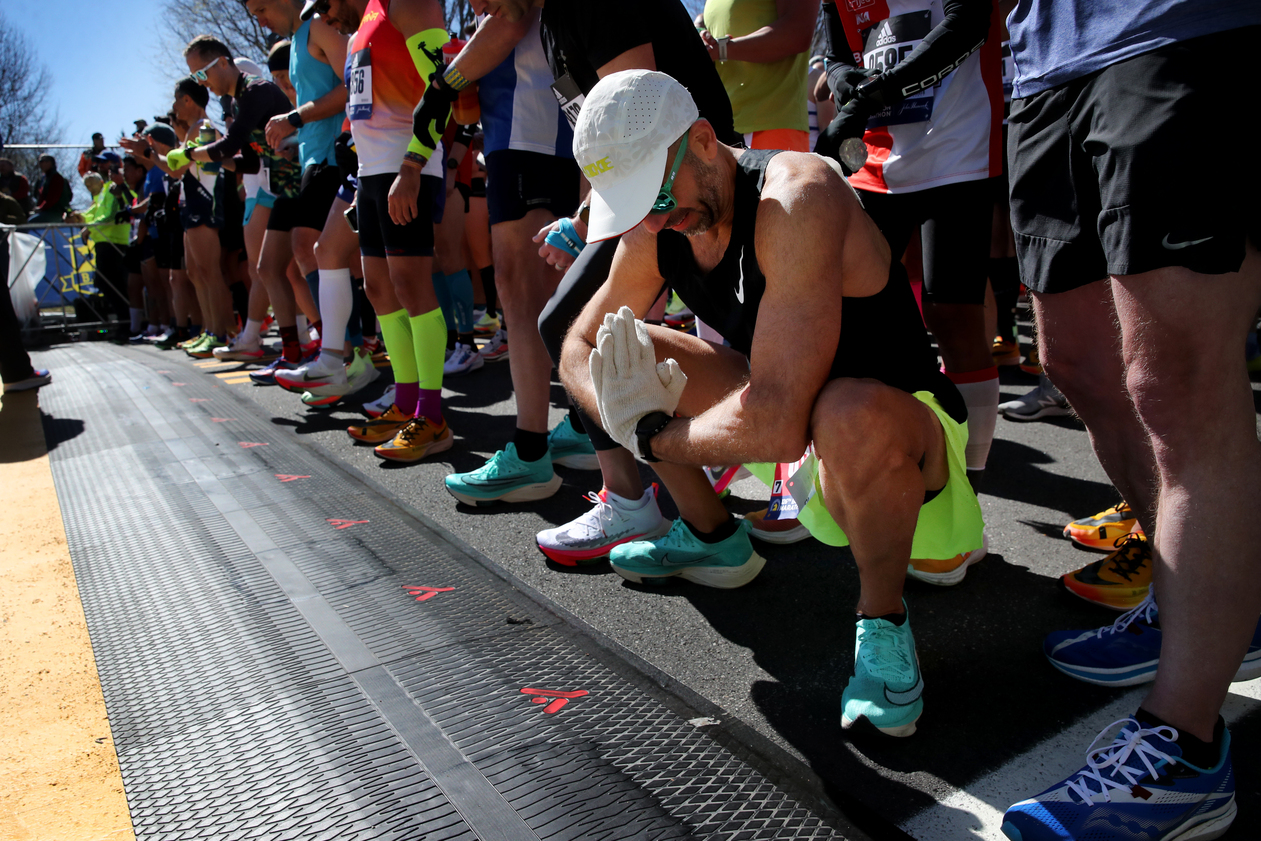

Featured
How To Start Training For Marathon
Modified: January 22, 2024
Get featured tips and techniques on how to start training for a marathon. Kickstart your running journey and prepare for the ultimate race.
Introduction
Welcome to the exciting world of marathon training! Whether you’re a seasoned runner looking to challenge yourself or a beginner ready to take on a new fitness goal, training for a marathon is a highly rewarding experience. Crossing that finish line after weeks or months of hard work and dedication is an accomplishment like no other.
However, embarking on marathon training requires careful planning and preparation. It is not a journey to be taken lightly. That’s why in this article, we will provide you with a comprehensive guide on how to start training for a marathon.
Before we dive into the nitty-gritty of training plans and workouts, it’s essential to understand that marathon training is a journey that requires commitment, discipline, and perseverance. It’s not just about running long distances; it’s about conditioning your body, nurturing your mind, and fueling both effectively.
Throughout this guide, we will walk you through the various stages of marathon training, addressing important factors such as setting goals, choosing the right training plan, building a base, incorporating strength and cross-training, focusing on nutrition and hydration, preventing injuries, mentally preparing yourself, increasing mileage, including speed and tempo training, balancing rest and recovery, and even developing race day strategies.
Whether you’re a first-time marathoner or aiming for a personal best, this article will provide you with the knowledge and guidance you need to succeed.
So, tighten your shoelaces, get ready to push your boundaries, and let’s begin this incredible journey towards conquering the marathon!
Setting Goals
Before you lace up your running shoes and hit the pavement, it’s essential to set clear and realistic goals for your marathon training. Setting goals not only gives you direction but also keeps you motivated throughout the entire process.
The first step in setting your marathon goals is to determine your “why.” Why do you want to run a marathon? Is it to challenge yourself physically and mentally? To achieve a new personal best? Or maybe it’s to support a charity or honor a loved one.
Once you have identified your motivation, it’s time to set specific, measurable, attainable, relevant, and time-bound (SMART) goals. For example, instead of saying, “I want to finish a marathon,” a SMART goal could be, “I want to complete the XYZ marathon in under 4 hours within the next 6 months.”
It’s also crucial to set both long-term and short-term goals. Long-term goals focus on the overall outcome, such as completing the marathon. Short-term goals, on the other hand, are smaller milestones that will help you reach your ultimate objective. These can include running a certain distance without stopping, improving your speed, or completing a half marathon as a stepping stone.
Remember, goal setting is a personal process. It’s important to be realistic and consider your current fitness level, time availability, and any limitations or challenges you may face. While aiming high is commendable, setting unrealistic goals can lead to disappointment or even injury.
Along with setting specific goals, it’s important to make them meaningful to you. Your goals should align with your values, passions, and aspirations. This will give you a stronger sense of purpose and drive as you tackle the ups and downs of marathon training.
Lastly, write down your goals and keep them visible throughout your training journey. This will serve as a constant reminder of what you’re working towards and help you stay focused and motivated.
Setting goals is not just about the destination; it’s also about the journey. Embrace the process, celebrate small victories along the way, and remember that your goals can evolve as you progress in your training. Now, let’s move on to the next step: choosing the right training plan to turn your goals into reality.
Choosing the Right Training Plan
One of the most critical factors in marathon training is selecting the right training plan that aligns with your goals, fitness level, and schedule. With countless plans available, it can be overwhelming to determine which one is best for you.
First and foremost, consider your experience level. Are you a beginner, intermediate, or advanced runner? If you’re new to marathons or have limited running experience, it’s advisable to start with a beginner-friendly plan that gradually increases your mileage and incorporates sufficient rest and recovery.
Next, evaluate your time availability. Marathon training requires a significant time commitment, so ensure that the plan you choose fits into your schedule. Look for plans that allow flexibility and can be customized to accommodate your personal and professional responsibilities.
Additionally, consider your training preferences and what aligns with your strengths as a runner. Some plans may focus more on speed work and tempo runs, while others prioritize long, endurance-building runs. Choose a plan that suits your running style and allows you to play to your strengths.
It’s also essential to consider your physical capabilities and any pre-existing injuries or health conditions. If you have any concerns, it’s best to consult with a healthcare professional or a running coach who can guide you in selecting a plan that won’t exacerbate any issues or put you at risk of injury.
Furthermore, take into account the plan’s progression and intensity. Ideally, the plan should have a gradual increase in mileage and intensity levels to prevent overexertion and reduce the risk of burnout or injury. Look for plans that incorporate rest days and recovery weeks to allow your body to adapt and recharge.
Finally, don’t underestimate the power of feedback and support. Seek advice from experienced runners, join running communities, or even consider hiring a running coach who can provide personalized guidance and support throughout your training journey.
Remember, choosing the right training plan is crucial, but it’s not set in stone. As you progress in your training, you may need to modify or adjust your plan based on your individual needs and progress.
Now that you understand the importance of selecting the right training plan, it’s time to lay the foundation for success in marathon training. In the next section, we’ll explore how to build a solid base to prepare your body for the more challenging aspects of your training plan.
Building a Base
Building a solid base is a fundamental step in marathon training. It involves gradually increasing your weekly mileage and improving your endurance to prepare your body for the more intense and lengthy runs ahead.
When starting with marathon training, it’s important to assess your current fitness level and running base. If you’ve been consistently running, you may already have a decent base and can progress more quickly. However, if you’re new to running or have taken a significant break, it’s crucial to start slowly and build your endurance gradually.
Begin by establishing a baseline mileage that you are comfortable with and can sustain without feeling overly fatigued. This could be anywhere between 10-20 miles per week, depending on your fitness level and previous experience.
From there, aim to increase your weekly mileage by around 10% each week. This gradual progression allows your body to adapt and build endurance while minimizing the risk of injury. It’s important to listen to your body and adjust the mileage increase based on how you feel.
In addition to increasing your mileage, focus on incorporating variety into your runs. This can include different terrains, paces, and types of runs. Gradually introduce speed work, tempo runs, and long, slow distance runs into your training routine. This variety helps improve your running economy, cardiovascular fitness, and overall endurance.
It’s essential to also pay attention to recovery during the base-building phase. Incorporate easy runs and rest days into your schedule to allow your body to repair and adapt to the increased training load. Stretching, foam rolling, and incorporating strength and cross-training exercises into your routine can also aid in recovery and prevent injury.
Lastly, don’t forget the importance of nutrition and hydration during your base-building phase. Fueling your body properly with a balanced diet and staying adequately hydrated will support your performance, aid in recovery, and help maintain optimal energy levels.
Building a solid base takes time and patience, but it sets the foundation for a successful marathon training journey. As you progress and feel more comfortable with your increased mileage and endurance, you’ll be ready to move on to the next phase, which involves incorporating strength and cross-training into your routine.
Strength and Cross-Training
Incorporating strength and cross-training into your marathon training regimen is not just an optional add-on; it is a crucial component that can enhance your performance, prevent injuries, and improve overall endurance.
Strength training, specifically targeting the muscles used in running, helps to develop power, stability, and muscular endurance. It can also improve your running form and efficiency, leading to better performance and reduced fatigue during long runs.
Focus on exercises that target your lower body, such as squats, lunges, deadlifts, and calf raises. Additionally, include exercises that target your core muscles, such as planks, mountain climbers, and Russian twists. Don’t forget about the upper body either – exercises like push-ups and rows can help maintain balance and contribute to overall strength.
When it comes to cross-training, choose activities that complement your running and provide a different type of workout. Activities like swimming, cycling, elliptical training, or rowing can be excellent options as they are low-impact, yet still provide cardiovascular benefits.
By incorporating strength and cross-training into your routine, you’ll not only strengthen your muscles but also give your body a break from the repetitive motions of running. This can reduce the risk of overuse injuries and provide a mental break as well.
It’s important to find the right balance between running, strength training, and cross-training. Aim to perform strength exercises 2-3 times per week, alternating between different muscle groups. As for cross-training, include it 1-2 times per week, depending on your training volume and schedule.
Remember to listen to your body and adjust your training as needed. If you feel excessively fatigued or notice any pain or discomfort, scale back or modify your strength and cross-training workouts accordingly. It’s better to be cautious and prioritize rest and recovery rather than risk compromising your marathon training.
In the next section, we will explore the importance of nutrition and hydration, and provide guidelines to ensure you fuel your body optimally throughout your marathon training journey.
Nutrition and Hydration
Proper nutrition and hydration are vital components of marathon training. Fueling your body with the right nutrients and staying adequately hydrated can optimize your performance, support recovery, and help you reach your training goals.
When it comes to nutrition, focus on consuming a well-balanced diet that includes a variety of whole foods. Aim to include complex carbohydrates, lean proteins, and healthy fats in every meal. Carbohydrates provide the necessary energy for running, while protein aids in muscle repair and recovery.
Prioritize whole grains, fruits, vegetables, lean meats, fish, eggs, legumes, nuts, and seeds in your diet. These foods provide essential vitamins, minerals, antioxidants, and fiber that support overall health and performance.
Timing your meals and snacks is crucial, especially before and after your runs. Prioritize pre-run meals that are rich in carbohydrates, moderate in protein, and low in fat and fiber to ensure easy digestion and steady energy release during your run. Post-run meals should contain a combination of carbohydrates and protein to replenish glycogen stores and support muscle repair and recovery.
In addition to your daily meals, fueling during long runs is essential to maintain optimal energy levels. Experiment with different types of fuel, such as energy gels, sports drinks, or real food options like bananas or energy bars, to find what works best for you. It’s essential to practice your fueling strategy during training to avoid any digestive issues on race day.
Hydration is equally vital for marathon training. Aim to drink water consistently throughout the day to stay hydrated. During your runs, sip on water or a sports drink to replenish fluids lost through sweat. Additionally, consider factors like weather conditions and your sweat rate to adjust your hydration needs accordingly.
Remember, hydration is not just about water intake; electrolytes play a crucial role as well. Electrolytes like sodium, potassium, and magnesium are essential for maintaining fluid balance, muscle function, and nerve transmission. Sports drinks or electrolyte supplements can help replenish electrolytes during and after intense workouts.
Lastly, be mindful of any supplements you choose to incorporate into your training. While some supplements may have their benefits, it’s always best to consult with a healthcare professional or a registered dietitian to determine if they are necessary for you and to ensure their safety and effectiveness.
Now that you understand the importance of nutrition and hydration in marathon training, it’s time to address another crucial aspect – injury prevention. In the next section, we will provide you with strategies to keep your body healthy and injury-free throughout your training journey.
Injury Prevention
When training for a marathon, injury prevention should be a top priority. A single injury can derail your progress and significantly impact your ability to meet your goals. Therefore, incorporating injury prevention strategies into your training plan is crucial to ensure you stay healthy and injury-free.
Firstly, listen to your body and be mindful of any warning signs or discomfort. Pain that persists or worsens during or after a run should not be ignored. It’s important to address any signs of injury promptly and seek appropriate medical attention if needed.
One of the most effective ways to prevent injuries is to incorporate regular strength and flexibility training into your routine. Exercises that target the muscles used in running, such as the hips, glutes, hamstrings, and calves, can help improve strength, stability, and prevent imbalances.
A strong core is also essential for maintaining proper running form and reducing the risk of injuries. Incorporate exercises like planks, bridges, and side planks to strengthen your core muscles.
Don’t overlook the importance of flexibility and mobility exercises as well. Dedicate time to stretch major muscle groups before and after each run. Including activities like yoga or Pilates in your routine can help improve flexibility and range of motion.
Proper footwear is another critical aspect of injury prevention. Invest in a good pair of running shoes that are suited to your foot type and running style. Consider getting fitted at a specialty running store to ensure you find the right shoe that provides adequate support and cushioning.
Additionally, do not overlook the importance of a gradual and progressive training plan. Avoid increasing your mileage or intensity too quickly, as this can lead to overuse injuries. Stick to the 10% rule, which advises increasing your weekly mileage by no more than 10% per week.
Rest and recovery are equally important in preventing injuries. Allow for adequate rest days and incorporate active recovery activities such as gentle walks or easy cross-training exercises. Listen to your body and take extra rest days or ease up on training if you are feeling excessively fatigued or experiencing any pain.
Finally, consider getting regular sports massages or incorporating self-massage techniques like foam rolling to help release muscle tension and improve recovery.
By implementing these injury prevention strategies, you can minimize the risk of injury and keep your marathon training on track. However, it’s important to remember that injuries can still occur. If you do experience an injury, be patient and seek professional guidance to ensure proper treatment and recovery.
Next, we will explore the essential aspect of mental preparation, which plays a significant role in marathon training and race day performance.
Mental Preparation
Mental preparation is a key component of marathon training. Running a marathon is as much a mental challenge as it is a physical one. Developing a strong mindset will help you overcome obstacles, stay motivated, and push through the tough moments throughout your training and on race day.
Firstly, set positive intentions and visualize your success. Take a few moments each day to imagine yourself crossing the finish line strong and achieving your goals. Visualizing success can help boost your confidence and keep you motivated during challenging training runs.
Next, practice positive self-talk. Replace negative thoughts with positive and encouraging phrases. Instead of telling yourself, “I can’t do this,” remind yourself, “I am capable and strong.” Empowering yourself with positive affirmations can make a significant difference in your mindset.
During long runs, break them down into smaller, manageable segments. Focus on one mile or one kilometer at a time. This helps to prevent overwhelm and can make the distance feel more attainable.
Training for a marathon can be physically and mentally exhausting, so it’s important to find strategies to stay motivated. Find what inspires you and use it to fuel your motivation. This could be listening to uplifting music, creating a motivating playlist, reading inspiring stories, or connecting with a running buddy or support group.
Develop mental toughness by embracing discomfort. Recognize that running a marathon will push you out of your comfort zone, and that’s where growth happens. Embrace the challenges and setbacks as opportunities for learning and personal growth.
Practice mindfulness and being present during your runs. Focus on your breath, the rhythm of your strides, and the sensations in your body. This helps to keep your mind engaged and can make the run feel more enjoyable and less daunting.
Learn relaxation techniques to manage pre-race jitters or performance anxiety. Deep breathing exercises, meditation, or visualization can help calm your nerves and promote a sense of relaxation and focus.
Lastly, celebrate each milestone and achievement during your training. Recognize and appreciate the progress you’ve made, whether it’s completing a long run, hitting a new personal record, or achieving a small goal. Celebrating these achievements will help boost your confidence and keep you motivated throughout your training journey.
By focusing on mental preparation and developing a strong mindset, you’ll be better equipped to overcome challenges, stay motivated, and ultimately, achieve success in your marathon training and on race day.
Now that we’ve covered the importance of mental preparation, let’s move on to the next section, which focuses on increasing mileage and building endurance in your training.
Increasing Mileage
As you progress in your marathon training, increasing your mileage is a critical step to build endurance and prepare your body for the grueling 26.2-mile distance. However, it’s important to approach mileage increases carefully and gradually to minimize the risk of injury and allow your body to adapt.
A general guideline is to increase your weekly mileage by no more than 10% each week. This gradual progression gives your muscles, tendons, and cardiovascular system time to adjust to the increased demands of running.
Start by adding an extra mile or two to your long run each week, keeping the rest of your runs at a consistent distance. This gradual approach allows your body to adapt without overwhelming it with sudden mileage jumps.
Every few weeks, consider incorporating a “step-back” week into your training plan. This means reducing your mileage to give your body a chance to recover and prevent overtraining. Step-back weeks can help prevent mental and physical burnout and reduce the risk of injuries.
Remember to listen to your body and be aware of any signs of fatigue or excessive soreness. If you feel excessively fatigued, consider taking an extra rest day or reducing the mileage for that week. Pushing through fatigue can lead to overtraining and increase the risk of injuries.
In addition to increasing your long run, gradually increase the mileage of your mid-week runs as well. This will help build your overall endurance and tolerance for longer distances.
As you increase your mileage, it’s important to pay attention to your running form and mechanics. Fatigue can lead to poor form, which not only diminishes running efficiency but can also increase the risk of injuries. Focus on maintaining good posture, a relaxed upper body, and an efficient stride throughout your runs.
Don’t forget to also prioritize rest and recovery during this phase. Adequate sleep, stretching, foam rolling, and incorporating rest days into your training plan will allow your body to repair and adapt to the increased mileage.
Lastly, keep in mind that everyone’s mileage tolerance is different. Some runners thrive on higher mileage, while others may be more prone to injuries with excessive volume. Listen to your body and find the mileage range that works best for you.
By gradually increasing your mileage, paying attention to your body, and allowing for adequate recovery, you’ll build the endurance necessary to conquer the marathon distance.
In the next section, we will discuss the importance of incorporating speed and tempo training into your training plan to improve your race pace and overall fitness.
Speed and Tempo Training
Speed and tempo training are essential components of marathon training that can improve your race pace, build strength, and enhance your overall fitness level. Incorporating these workouts into your training plan will help you develop the speed and endurance necessary to achieve your marathon goals.
Speed training involves shorter, faster intervals that push your body to run at a higher pace than your normal training pace. These intervals could range from 200 meters to 1 mile in distance, depending on your fitness level and goals. The goal of speed training is to improve your leg turnover, running economy, and anaerobic capacity.
Tempo runs, on the other hand, are sustained runs at a comfortably hard pace, just below your lactate threshold. These runs are typically longer, ranging from 3 to 6 miles or more, and are aimed at improving your stamina and ability to sustain a faster pace over a longer distance.
When incorporating speed and tempo training, it’s important to warm up properly before each workout. Begin with a few minutes of easy running, followed by dynamic stretches or exercises that target your hip flexors, hamstrings, and calves. This warm-up routine will help prepare your muscles for the increased intensity.
During speed workouts, strive to maintain good form and focus on proper running mechanics. Engage your core, maintain an upright posture, and aim for quick turnover and light foot strikes. These workouts can be done on a track or measured loop, ensuring you have a consistent distance to track your progress.
Tempo runs should be challenging but sustainable. Pace yourself to run at a comfortably hard effort level that you can maintain for the duration of the run. This will help improve your lactate threshold and teach your body to get comfortable with running at a faster pace for longer distances.
It’s important to note that speed and tempo training should not be done on consecutive days. Allow for adequate rest and recovery between these workouts to prevent overuse injuries and ensure optimal performance.
As with any training, it’s crucial to listen to your body and adjust the intensity and duration of these workouts based on your fitness level and recovery status. Gradually increase the distance or duration of your speed and tempo runs over time to continue challenging your body and seeing progress.
Incorporating speed and tempo training into your marathon training plan will not only improve your race pace but also enhance your overall running performance. It’s time to push your limits, challenge yourself, and take your training to the next level!
In the next section, we will delve into the importance of rest and recovery in marathon training.
Rest and Recovery
Rest and recovery are often overlooked aspects of marathon training, but they are crucial for optimal performance, injury prevention, and overall well-being. Giving your body time to rest and recover allows it to adapt, repair, and come back stronger for future training sessions.
During the intense training phase, it’s important to prioritize proper rest. Schedule regular rest days into your training plan to give your body time to rejuvenate and repair. Rest days can be complete rest or active recovery days where you engage in low-impact activities such as gentle walks, yoga, or stretching.
Along with rest days, adequate sleep plays a vital role in recovery. Aim to get 7-9 hours of quality sleep each night to optimize physical and mental recovery. Sleep is crucial for muscle repair, hormone production, immune function, and mental well-being.
Listen to your body and be aware of signs of overtraining or burnout. Feeling excessively fatigued, experiencing persistent muscle soreness, or noticing a decline in performance could be indications that you need more rest. It’s better to take an extra day off or reduce your training volume than to push through and risk injury.
Incorporating recovery strategies such as foam rolling, stretching, and mobility exercises can help alleviate muscle tension, improve flexibility, and promote blood circulation. Massage therapy or self-massage techniques can also aid in recovery and relaxation.
Proper nutrition is another critical component of recovery. Consuming a balanced diet with sufficient protein, carbohydrates, and healthy fats helps replenish energy stores, repair muscle tissue, and support the body’s recovery processes. Be sure to include a combination of lean proteins, fruits, vegetables, whole grains, and healthy fats in your meals and snacks.
Hydration is also important for recovery. Replenish fluids lost during training sessions by drinking water or electrolyte-rich beverages. Adequate hydration supports optimal muscle function, joint lubrication, and nutrient delivery.
Mental recovery is just as important as physical recovery. Incorporate activities that help you relax and unwind, such as meditation, deep breathing exercises, or spending time in nature. Taking care of your mental well-being will help you approach each training session with focus and a positive mindset.
Remember, rest and recovery are not signs of weakness but rather critical components of a successful training program. Embrace the rest days and allow your body the time it needs to recover, recharge, and come back stronger.
We have covered the importance of rest and recovery in marathon training. In the final section, we will discuss race day strategies that will help you perform your best on the big day.
Race Day Strategies
After months of training and preparation, race day has finally arrived. To ensure a successful marathon experience, it’s essential to have a solid race day strategy in place. Here are some key strategies to help you perform your best:
Start with a good night’s sleep and wake up early enough to allow ample time for a proper breakfast. Stick to familiar foods that you have tested during your long training runs to avoid any digestive issues on race day.
Arrive at the race venue with plenty of time before the start to check-in, use the facilities, and warm up adequately. Performing dynamic exercises and a few easy strides can help activate your muscles and get you mentally prepared.
When the race begins, don’t get caught up in the excitement and start too fast. Stick to your planned pace and make gradual adjustments as you settle into the race. Avoid going out too hard, as this can lead to early fatigue and difficulties later on.
Stay mentally focused and break the race into smaller segments. Instead of thinking about the entire distance, focus on running one mile or kilometer at a time. Set mini-goals or landmarks to distract yourself and keep your mind engaged.
Hydration and fueling are crucial during the race. Follow your pre-determined fueling strategy, whether it’s consuming energy gels, sports drinks, or real food. Take advantage of water stations along the course and hydrate regularly, especially on warmer days.
Throughout the race, be mindful of your running form and maintain good posture. Relax your shoulders, engage your core, and keep your strides smooth and efficient. This will help conserve energy and reduce the risk of injuries.
Use the crowd support and energy to your advantage. High-five spectators, smile, and draw inspiration from their cheers. Their encouragement can boost your spirits and provide a mental lift when you need it.
If you hit a rough patch during the race, stay positive and remember why you started this journey. Use your mental strength and positive self-talk to overcome any doubts or negative thoughts. Channel your mental resilience and visualize your success.
In the final miles of the race, stay mentally tough and push through any fatigue or discomfort. Dig deep and give it your all, knowing that the finish line is within reach. Trust in your training and believe in your abilities.
Celebrate your accomplishment as you cross the finish line. Take a moment to reflect on the dedication, hard work, and perseverance that brought you to this moment. Smile, take in the atmosphere, and savor the sense of achievement.
After finishing the race, prioritize post-race recovery. Wear compression gear, rehydrate, and consume a snack or meal containing a balance of carbohydrates and protein within 30-60 minutes of finishing to aid in muscle recovery.
Remember, each marathon experience is unique, and race day can bring unexpected challenges. Stay flexible and adapt your strategy as needed. Most importantly, enjoy the entire marathon experience and the incredible sense of accomplishment that comes with crossing the finish line.
Congratulations on embarking on this marathon journey. You are well-prepared and ready to conquer the challenge. Now, go out there and make your marathon dreams a reality!
Conclusion
Congratulations on completing this comprehensive guide on how to start training for a marathon! By now, you should have a solid understanding of the key aspects involved in preparing for the challenge of running 26.2 miles.
We’ve covered important topics such as setting goals, choosing the right training plan, building a base, incorporating strength and cross-training, focusing on nutrition and hydration, preventing injuries, mental preparation, increasing mileage, speed and tempo training, rest and recovery, and race day strategies.
Throughout your marathon training journey, it’s crucial to prioritize your physical and mental well-being. Listen to your body, embrace the challenges, and be flexible with your training plan as needed.
Remember, marathon training is not just about the destination; it’s about the journey and the personal growth you’ll experience along the way. Celebrate every milestone, learn from setbacks, and stay motivated by focusing on your “why.”
On race day, trust in your training and believe in yourself. Take in the atmosphere, draw strength from the support of fellow runners and spectators, and enjoy every step towards the finish line.
Completing a marathon is an incredible achievement that requires dedication, perseverance, and mental toughness. The physical and mental strength you gain through this training process will extend far beyond just running the race.
So, lace up your shoes, take a deep breath, and embark on this incredible journey towards conquering a marathon. With proper training, determination, and a positive mindset, you are well-equipped to Cross the finish line and embrace the incredible sense of accomplishment that comes with completing a marathon.
Best of luck as you begin your marathon training! Enjoy the process, stay motivated, and remember that you are capable of achieving greatness. Your marathon journey awaits!









